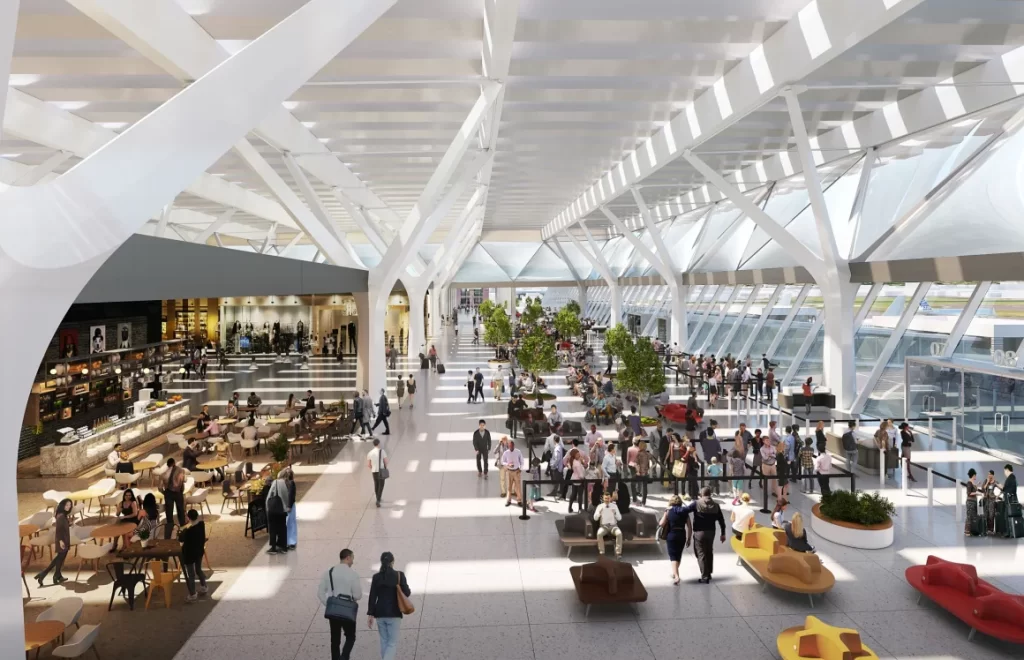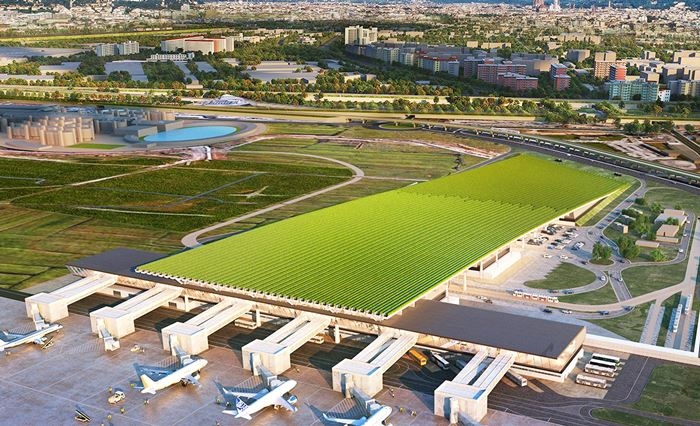News
Cultivating Change: Florence’s Vineyard-Topped Airport Terminal and the Evolution of Sustainable Design in Aviation
In the heart of Tuscany, the enchanting city of Florence is preparing to redefine its skyline with a groundbreaking addition – an international terminal adorned with a sprawling vineyard on its roof. Spearheaded by the visionary minds at New York-based firm Rafael Viñoly Architects, this ambitious project not only aims to reshape the aesthetic landscape of the city but also stands as a beacon of commitment to sustainable architecture. Let’s find out with nowglas.

The Aeroporto Amerigo Vespucci’s international terminal is poised to become a new landmark, echoing Florence’s rich cultural heritage while symbolizing a leap into a more sustainable future. The 19-acre vineyard crowning the terminal pays homage to Tuscany’s iconic landscapes and, simultaneously, acts as an architectural marvel, concealing a commitment to innovation beneath its verdant canopy.
Projected for completion in two phases, with milestones set for 2026 and 2035, this terminal aspires to be more than just an architectural masterpiece. Sustainability takes center stage in its design, reflecting a growing acknowledgment of the environmental impact of construction and operation in an era where such considerations are pivotal.
As the construction sector and built environments contribute a staggering 40% of global energy-related carbon emissions, and commercial aviation adds about 2.5% to the overall emissions tally, innovative solutions are crucial. Traditionally, efforts to mitigate aviation’s impact have focused on alternative fuels, from cooking oil to sewage. However, Florence’s forthcoming terminal shifts the focus to the very infrastructure and construction processes involved in airport development.

At the core of the terminal’s design is the expansive green roof – a 19-acre vineyard designed not only for aesthetic allure but also environmental benefits. The sloped structure of the roof, combined with features engineered for energy efficiency, aspires to set a new standard for sustainable airport design.
“The concept of the building is to recreate the most quintessential Tuscan landscape, which is the vineyard — and then to peel one end of the vineyard up from the floor to create a slope, and slide an airport underneath that slope,” explains Román Viñoly, director of Rafael Viñoly Architects. This innovative approach not only captures the essence of Tuscany’s vineyard-strewn hills but also introduces a unique architectural perspective to airport design.
A key element in the design is the berm, a mound of soil and earth that comprises the first third of the building’s length. Equipped with heat exchanger coils, this soil mound facilitates heat exchange between the earth and the building, establishing an efficient system for regulating interior temperatures. This strategic incorporation of natural elements sets the Florence terminal apart as a model for sustainable design in airport infrastructure.
Solar panels and translucent photovoltaic panels are seamlessly integrated into the roof, adding to the project’s commitment to renewable energy. Placed between the vine rows, these panels aim not only to enhance energy efficiency but also to create a visual connection between passengers inside the terminal and the lush vineyard outside. The careful consideration of aesthetics and functionality demonstrates an unwavering commitment to sustainable energy practices.
Yet, amid the praise for the project’s innovative design and sustainability goals, some experts raise valid concerns. Filippo Weber, a member of the Italian Climate Network, points to potential challenges such as the vineyard’s demand for water and its seasonal carbon offsetting capabilities. He emphasizes the need for a comprehensive evaluation of the project’s sustainable benefits beyond its visual appeal, urging a balanced perspective on its environmental impact.
While the debate over the specifics continues, the architects behind the project view it as a transformative catalyst. Rafael Viñoly Architects envisions the Florence airport’s vineyard-topped terminal as an inspiration for airports worldwide to prioritize sustainability. Beyond the architectural feat, the goal is to redefine airports from mere transitional spaces to destinations actively contributing to a greener future.
As Florence’s airport undergoes this metamorphosis, it emerges not only as a symbol of architectural innovation but also as a testament to the evolving priorities within the aviation industry. The harmonious blend of aesthetics and sustainability signals a potential paradigm shift, encouraging airports globally to embrace greener practices and recognize their role as integral destinations in the journey towards a sustainable future.
The vineyard-topped terminal in Florence is more than an architectural endeavor; it embodies a broader narrative of change in aviation. Beyond the shimmering glass and steel, the project seeks to sow the seeds of transformation, urging the industry to reflect on its environmental footprint and adopt practices that echo the call for a greener tomorrow.
In the grand tapestry of sustainable design, the Florence airport’s terminal represents a brushstroke that combines innovation, aesthetics, and environmental stewardship. Its vineyard-draped roof is not merely an ornament but a statement – a living testament to the possibility of reimagining airports as ecological havens rather than environmental stressors.
As the world watches the evolution of Florence’s airport terminal, it serves as a reminder that the sky is no longer the limit when it comes to architectural imagination. The vineyard on the roof is a metaphorical vine connecting the realms of tradition and innovation, urging the aviation industry to transcend conventional boundaries and embrace a future where sustainability is not an afterthought but an integral part of the journey.
See more: Budget 2024: Cigarette Prices Soar to Over £16 in UK
